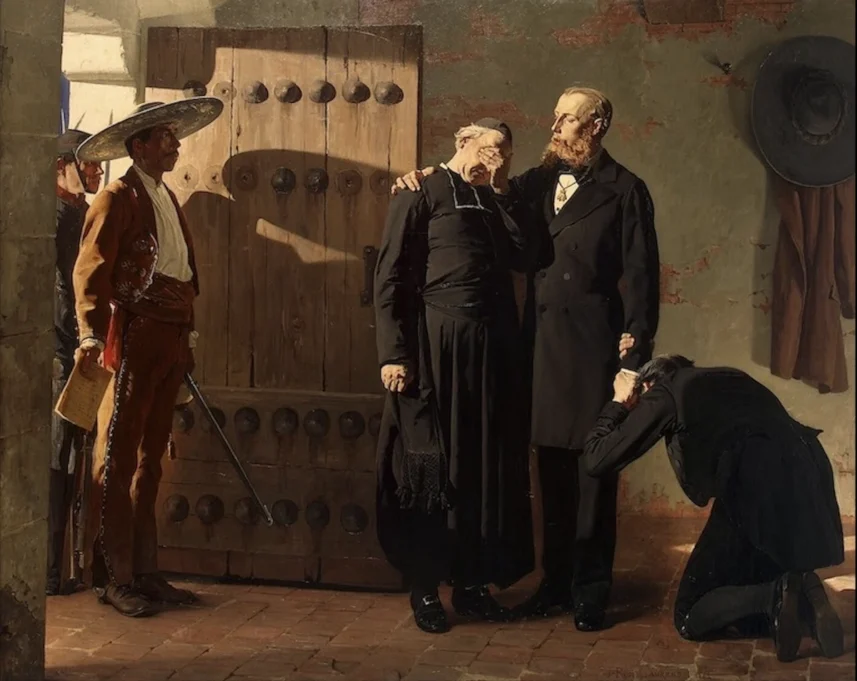
Enchiladas Suizas is a dish shrouded in a mysterious past. Literally translated Enchiladas Suizas means “Swiss enchiladas,” a name attributed by some to the large amount of cheese and cream resembling the Swiss alps and by others to culinary influences from Swiss immigrants on Mexican cuisine. Enchiladas are a traditional staple deeply rooted in Mexico’s past. Derived from corn, tortillas originated in Mexico and date back to Mayan times. Corn is one of the most ancient food staples. Originally known as maize (Zea mays1), corn or maize is believed to have been selectively domesticated in Mexico from a wild grass progenitor of corn called teosinte. Enchiladas Suizas are an example of “Old World” meets “New World” cuisine , although no one can seem to decide who deserves credit for the dish. Most recently I read an article stating that the dish originated at Sanborns in Mexico City in 1950. Another article claimed the dish might have originated in the kitchen of Emperor Maximillian during the 1862 French invasion of Mexico under Emperor Napoleon III. Ferdinand Maximilian Josef Maria (later known as Emperor Maximillian I) was an Austrian noble elected by the Assembly of Notables formed during the French intervention. Maximillian I ruled as the Emperor of the Second Mexican Empire from 1864 through 1867. Maximillian’s rule was short lived however; in 1867 he was accused of attempting to overthrow the Mexican government, found guilty and executed by firing squad on June 19,1867. His execution was considered a tragic but necessary act to firmly establish Mexican independence and to discourage future invasions by foreign governments.

Yet, while Maximillian’s reign may have been brief, it was not insignificant. In fact, he is often cited as the ruler who brought marching bands and folk musicians to Mexico. Subsequently and over time, European instruments like the accordion were assimilated and incorporated into traditional Mexican music and Mariachi bands. Following Maximillian’s demise, some French expats fled to the United States, but many who had emigrated earlier chose to remain. In fact (per the 1910 census2) French was the third most spoken foreign language in Mexico. Interestingly, the second most popular foreign language was Chinese! Today in Mexico, French communities continue to thrive, particularly in the private education sector where the Lycée Franco-Mexicain in Mexico City maintains one of the largest Lycees in the world. According to the Population and Housing Census from 2010, they continue to represent a significant part of Mexico’s immigrant population. The “French effect” can be seen throughout Mexico in its music, art, French-inspired architecture, cafes and beyond. The French influence on Mexican cuisine has been well-documented and there is little doubt that the two cultures make for an excellent gastronomic pairing. The history and cultural connections between France and Mexico are frequently underappreciated. The first wave of French immigrants began in the early 1800’s following France’s official recognition of Mexican Independence. French citizens living in Mexico introduced their techniques and paired them with the traditional ingredients and spices of each region; the results were phenomenal and also served as a catalyst for The Pastry War in 1838. When made correctly, the sauce of Enchiladas Suizas bears the signature of classic French cuisine, with a consistency reminiscent of a Sauce aux Poivrons Vert or Sauce à la Moutarde.

Whatever its precise origins, when properly made, Enchiladas Suizas will delight even the most discerning critic. Mexican-born French-trained chef Roberto Santibanez has spoken and written extensively on Mexican cuisine; a great article on recipes and suggested wine pairings may be found at Mexican Made Easy and another recipe at Food Republic. Should you be pressed for time and want a quick and easy version of Enchiladas Suizas, simply prepare the dish per your favorite recipe and substitute a pre-made verde sauce such as chef Rick Bayless’ Frontera brand Green Chile Enchilada Sauce with roasted tomatillo and garlic. Old El Paso and Herdez enchilada sauces are also popular and widely available in both roja (red chili) and verde (green chili) versions. Buen apetito!
Photo credit : Top of page : “Hot air balloon ride over the pyramids of the Teotihuacan archaeological site, Mexico” by roblesloaiza/ CC0 1.0
References:
- Teosinte and the domestication of maize : https://evolution.earthathome.org/grasses/andropogoneae/maize-domestication/
- Speakers of foreign languages in Mexico (1910-1950) https://www.indigenousmexico.org/articles/speakers-of-foreign-languages-in-mexico-1910-1950
- Knowing … us all: Population and Housing Census 2010] (PDF). INEGI (in Spanish). May 2011. Archived from the original (PDF) on 27 April 2013. Retrieved 5 January 2015.
Post article trivia : Tortillas and the origins of corn….

A cornfield for comparison:

Corn’s ancestor was a form of wild grass selectively bred over thousands of years to create larger kernels. So technically when you eat corn (or a corn tortilla enchilada) you’re essentially consuming a highly cultivated form of grass.

